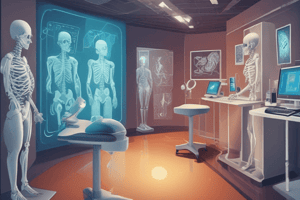Podcast
Questions and Answers
What is the most common type of delayed contrast reaction?
What is the most common type of delayed contrast reaction?
- Cutaneous reactions (correct)
- Laryngeal edema
- Cardiopulmonary arrest
- Nephropathy
What is the timeframe for delayed contrast reactions to occur?
What is the timeframe for delayed contrast reactions to occur?
- After 7 days of contrast administration
- Immediately after contrast administration
- Within 30 minutes of contrast administration
- Anywhere from 3 hours to 7 days following the administration of contrast (correct)
What is a severe reaction that can rapidly escalate to a life-threatening situation?
What is a severe reaction that can rapidly escalate to a life-threatening situation?
- Delayed contrast reactions
- Cutaneous reactions
- Severe reactions (correct)
- Bronchospasm
What is the reported incidence of cutaneous reactions?
What is the reported incidence of cutaneous reactions?
What is a common symptom of cutaneous reactions?
What is a common symptom of cutaneous reactions?
What is the primary treatment for symptoms of cutaneous reactions?
What is the primary treatment for symptoms of cutaneous reactions?
What is the maximum dose of diazepam that can be administered?
What is the maximum dose of diazepam that can be administered?
What is the recommended route of administration for epinephrine in pediatrics?
What is the recommended route of administration for epinephrine in pediatrics?
What is the dosage of nitroglycerin used to treat acute angina?
What is the dosage of nitroglycerin used to treat acute angina?
What is the classification of diazepam?
What is the classification of diazepam?
What is the strength of epinephrine that should NOT be used for IV injection?
What is the strength of epinephrine that should NOT be used for IV injection?
What system categorizes children into one of eight color zones based on their weight and height?
What system categorizes children into one of eight color zones based on their weight and height?
What is the limitation of using serum creatinine to monitor renal function?
What is the limitation of using serum creatinine to monitor renal function?
What is the widely accepted figure of serum creatinine that indicates significant renal insufficiency?
What is the widely accepted figure of serum creatinine that indicates significant renal insufficiency?
What is the limitation of creatinine clearance derived from 24-hour urine collection?
What is the limitation of creatinine clearance derived from 24-hour urine collection?
Why is glomerular filtration rate (GFR) a more sensitive indicator of renal function than serum creatinine?
Why is glomerular filtration rate (GFR) a more sensitive indicator of renal function than serum creatinine?
What is the consequence of using a cut-off value of 1.5 mg/dL for serum creatinine?
What is the consequence of using a cut-off value of 1.5 mg/dL for serum creatinine?
What is the reason for the development of alternative predictors of GFR?
What is the reason for the development of alternative predictors of GFR?
What is the general definition of acute renal failure in terms of serum creatinine?
What is the general definition of acute renal failure in terms of serum creatinine?
How long does it take for serum creatinine to peak in acute renal failure?
How long does it take for serum creatinine to peak in acute renal failure?
What is a common clinical manifestation of acute renal failure?
What is a common clinical manifestation of acute renal failure?
What is a potential consequence of severe acute renal failure?
What is a potential consequence of severe acute renal failure?
Which patients are at higher risk of contrast-induced nephrotoxicity due to dehydration?
Which patients are at higher risk of contrast-induced nephrotoxicity due to dehydration?
Which group of diabetes patients is likely at higher risk of contrast-induced renal toxicity?
Which group of diabetes patients is likely at higher risk of contrast-induced renal toxicity?
What is the primary route of excretion for iodipamide?
What is the primary route of excretion for iodipamide?
What is the reason for using iodipamide to image the biliary system?
What is the reason for using iodipamide to image the biliary system?
What is the increased risk for patients with compromised hepatic function who receive iodipamide?
What is the increased risk for patients with compromised hepatic function who receive iodipamide?
What is the primary advantage of gadolinium-based contrast agents over iodinated contrast agents?
What is the primary advantage of gadolinium-based contrast agents over iodinated contrast agents?
What is the composition of the solution infused over 30 minutes before CT imaging?
What is the composition of the solution infused over 30 minutes before CT imaging?
What is the similarity between CT and MR contrast agents?
What is the similarity between CT and MR contrast agents?
Flashcards are hidden until you start studying




